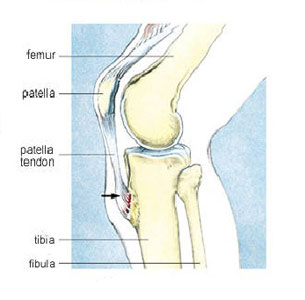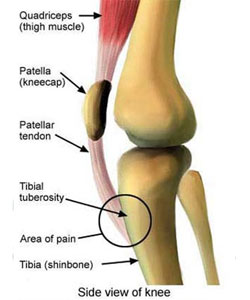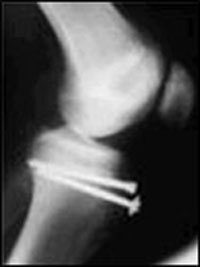Osgood-Schlatter Disease
Introduction:
It is a condition caused due to overuse, affecting the upper part of the shinbone (Tibial Tuberosity). It is most common in adolescents who are active in sports. This condition can cause an enforced lay off for gifted sports people between the ages of 9 and 14 years. It is more common in males than in females.

Pathophysiology:
The Tibial Tuberosity is an apophysis (an area of bone where Muscles and tendons attach).
The strong quadriceps or thigh Muscles are attached to the Tibial Tuberosity. During adolescence, when the bone is still immature and has not yet fully hardened, it is susceptible to the pull caused by the contraction of the thigh Muscles. Repeated sporting activity, without allowing the bone to rest and adapt, leads to inflammation of the Tibial Tuberosity - this is what causes the symptoms of pain and swelling.
In some cases the pull of the strong thigh Muscles on the immature bone can actually pull the Tibial Tuberosity away from the shinbone. This is called an avulsion fracture. Sometimes the initial inflammation may be a result of trauma such as a kick to the Tibial Tuberosity, that leads to Osgood-Schlatter. Once Osgood-Schlatter has established itself it can persist for in excess of a year.
Clinical Features:
- Waxing and waning anterior Knee pain for months
- Bilateral in up to one third of the patients
Knee pain aggravated by:
- Running
- Jumping or hurdling
- Going up and down stairs
- Kneeling or squatting

Signs :
- Localized tenderness and swelling at Tibial Tuberosity
- Provocative Maneuvers
Knee extension against resistance
Passive Knee Hyperflexion
Investigations :
X-rays:

Femur X-ray
Conservative Management:
- Osgood-Schlatter
- Rest by reducing physical activity
- Ice fomentation
- Anti-inflammatory medications
- Consider strap
- Knee immobilizer splint may occasionally be useful
- Quadriceps strengthening

Surgical Management:
Rarely required, but done in extreme cases where pain is intolerable.
